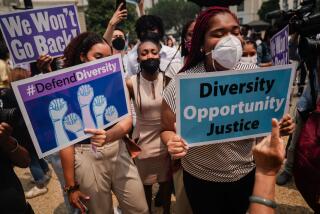Affirmative Action Ruling
- Share via
Justice William J. Brennan Jr., in the 1979 Weber case involving racial discrimination, maintained that “Congress did not intend wholly to prohibit private and voluntary affirmative action efforts as one method of solving this problem” of racial discrimination. This principle has now been applied to sexual discrimination in an affirmative action case.
Both the recent court case and the Weber case involved people who had not been discriminated against yet who were beneficiaries of preferential treatment because of their race or sex. What is the principle providing the motivating force behind these court case decisions? The U.S. Supreme Court has ruled that “an employer may promote a woman over a better qualified man to remedy a ‘statistical imbalance’ in its work force.”
The moral principle that the best qualified person should be hired for the job is now just an irrelevant notion, to be superseded by aesthetic considerations for the proper average number of male and female organs, and the proper average skin shade, in the work force. The broader principle that all people are created equal, which is the origin of the 14th Amendment to the U.S. Constitution, is now legally dead. It is only a matter of time before it is culturally dead, to be replaced by the principle that, to paraphrase George Orwell, “all people are equal, but some are more equal than others.”
MICHAEL BACHWANSKY
Leona Valley
More to Read
Get the L.A. Times Politics newsletter
Deeply reported insights into legislation, politics and policy from Sacramento, Washington and beyond. In your inbox twice per week.
You may occasionally receive promotional content from the Los Angeles Times.










